fuel type TOYOTA RAV4 PLUG-IN HYBRID 2023 User Guide
[x] Cancel search | Manufacturer: TOYOTA, Model Year: 2023, Model line: RAV4 PLUG-IN HYBRID, Model: TOYOTA RAV4 PLUG-IN HYBRID 2023Pages: 718, PDF Size: 167.55 MB
Page 222 of 718

2203-1. Instrument cluster
■ Settings
“Language”
Select to change the language
on the multi-information display.
“Units”
Select to change the unit of mea-
sure for fuel consumption.
Meter Type
Select to change the meter type
setting.
Meter Style
Select to change the meter style.
Dial Type
Select to change dial type.
( P.193)
Depending on the selected dial type,
this item will not be displayed.
EV indicator
Select to enable/disable the EV
indicator.
Fuel Economy
Select to change the display on
Fuel Economy. ( P.213)
“Hybrid System”
Select to enable/disable refer-
ence operation range.
“Power Consumption”
Select to change the display on
Power Consumption. ( P.213)
Drive Info
Select to change displayed items
on drive information display.
( P.216)
Pop-Up Display
Select to enable/disable the pop-
up displays, which may appear in
some situations.
“Calender”
Select to set up the calender.
This can only be set if GPS cali-
bration of clock is turned off in
the multimedia system settings.
Default Settings
Select to reset the meter display
settings.
■Suspension of the settings display
●In the following situations, operation of the settings display will be temporarily
suspended. • When a warning message appears on the multi-information display
• When the vehicle begins to move
●Settings for functions not equipped to
the vehicle are not displayed.
●When a function is turned off, the
related settings for that function are not selectable.
WARNING
■Cautions during setting up the
display
As the hybrid system needs to be operating during setting up the dis-
play, ensure that the vehicle is parked in a place with adequate ventilation. In a closed area such as a garage,
exhaust gases including harmful car- bon monoxide (CO) may collect and enter the vehicle. This may lead to
death or a serious health hazard.
NOTICE
■During setting up the display
To prevent 12-volt battery discharge, ensure that the hybrid system is oper-
ating while setting up the display fea- tures.
Page 338 of 718
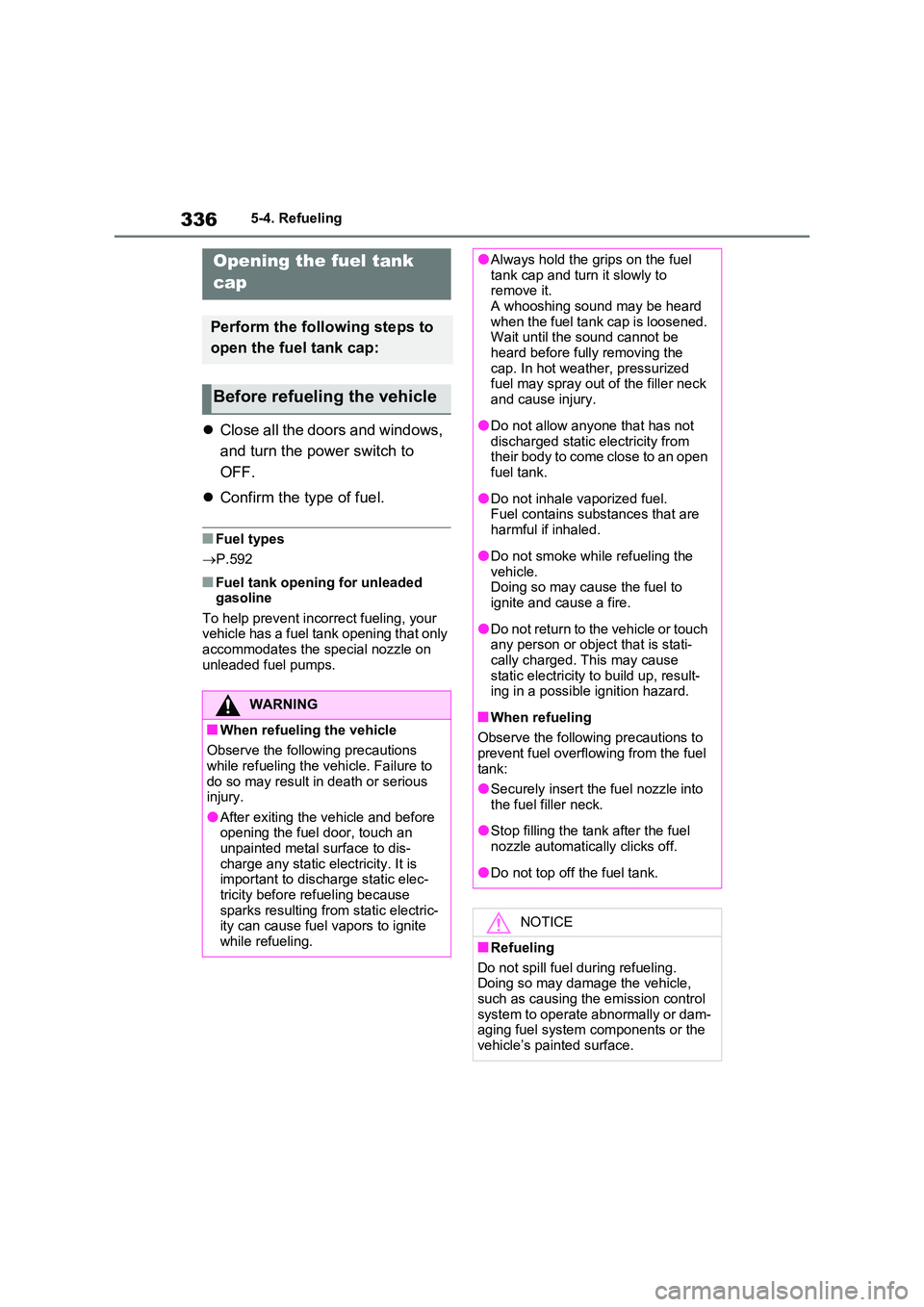
3365-4. Refueling
5-4.Refuelin g
Close all the doors and windows,
and turn the power switch to
OFF.
Confirm the type of fuel.
■Fuel types
P.592
■Fuel tank opening for unleaded gasoline
To help prevent incorrect fueling, your vehicle has a fuel tank opening that only accommodates the special nozzle on
unleaded fuel pumps.
Opening the fuel tank
cap
Perform the following steps to
open the fuel tank cap:
Before refueling the vehicle
WARNING
■When refueling the vehicle
Observe the following precautions
while refueling the vehicle. Failure to do so may result in death or serious injury.
●After exiting the vehicle and before opening the fuel door, touch an unpainted metal surface to dis-
charge any static electricity. It is important to discharge static elec-tricity before refueling because
sparks resulting from static electric- ity can cause fuel vapors to ignite while refueling.
●Always hold the grips on the fuel tank cap and turn it slowly to remove it.
A whooshing sound may be heard when the fuel tank cap is loosened. Wait until the sound cannot be
heard before fully removing the cap. In hot weather, pressurized fuel may spray out of the filler neck
and cause injury.
●Do not allow anyone that has not
discharged static electricity from their body to come close to an open fuel tank.
●Do not inhale vaporized fuel.Fuel contains substances that are
harmful if inhaled.
●Do not smoke while refueling the
vehicle. Doing so may cause the fuel to ignite and cause a fire.
●Do not return to the vehicle or touch any person or object that is stati-
cally charged. This may cause static electricity to build up, result-ing in a possible ignition hazard.
■When refueling
Observe the following precautions to
prevent fuel overflowing from the fuel tank:
●Securely insert the fuel nozzle into
the fuel filler neck.
●Stop filling the tank after the fuel
nozzle automatically clicks off.
●Do not top off the fuel tank.
NOTICE
■Refueling
Do not spill fuel during refueling. Doing so may damage the vehicle,
such as causing the emission control system to operate abnormally or dam-aging fuel system components or the
vehicle’s painted surface.
Page 417 of 718
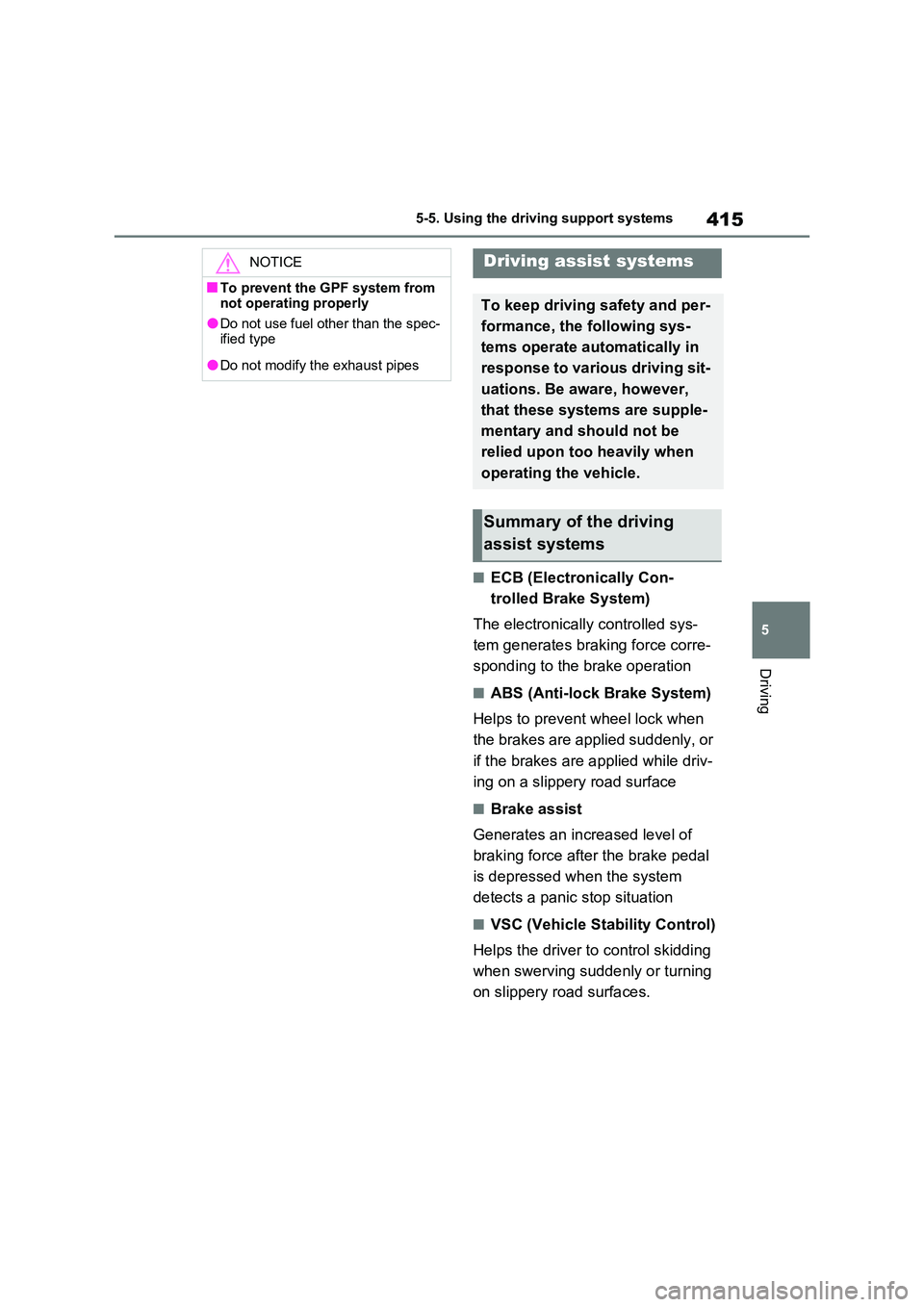
415
5
5-5. Using the driving support systems
Driving
■ECB (Electronically Con-
trolled Brake System)
The electronically controlled sys-
tem generates braking force corre-
sponding to the brake operation
■ABS (Anti-lock Brake System)
Helps to prevent wheel lock when
the brakes are applied suddenly, or
if the brakes are applied while driv-
ing on a slippery road surface
■Brake assist
Generates an increased level of
braking force after the brake pedal
is depressed when the system
detects a panic stop situation
■VSC (Vehicle Stability Control)
Helps the driver to control skidding
when swerving suddenly or turning
on slippery road surfaces.
NOTICE
■To prevent the GPF system from not operating properly
●Do not use fuel other than the spec-ified type
●Do not modify the exhaust pipes
Driving assist systems
To keep driving safety and per-
formance, the following sys-
tems operate automatically in
response to various driving sit-
uations. Be aware, however,
that these systems are supple-
mentary and should not be
relied upon too heavily when
operating the vehicle.
Summary of the driving
assist systems
Page 426 of 718
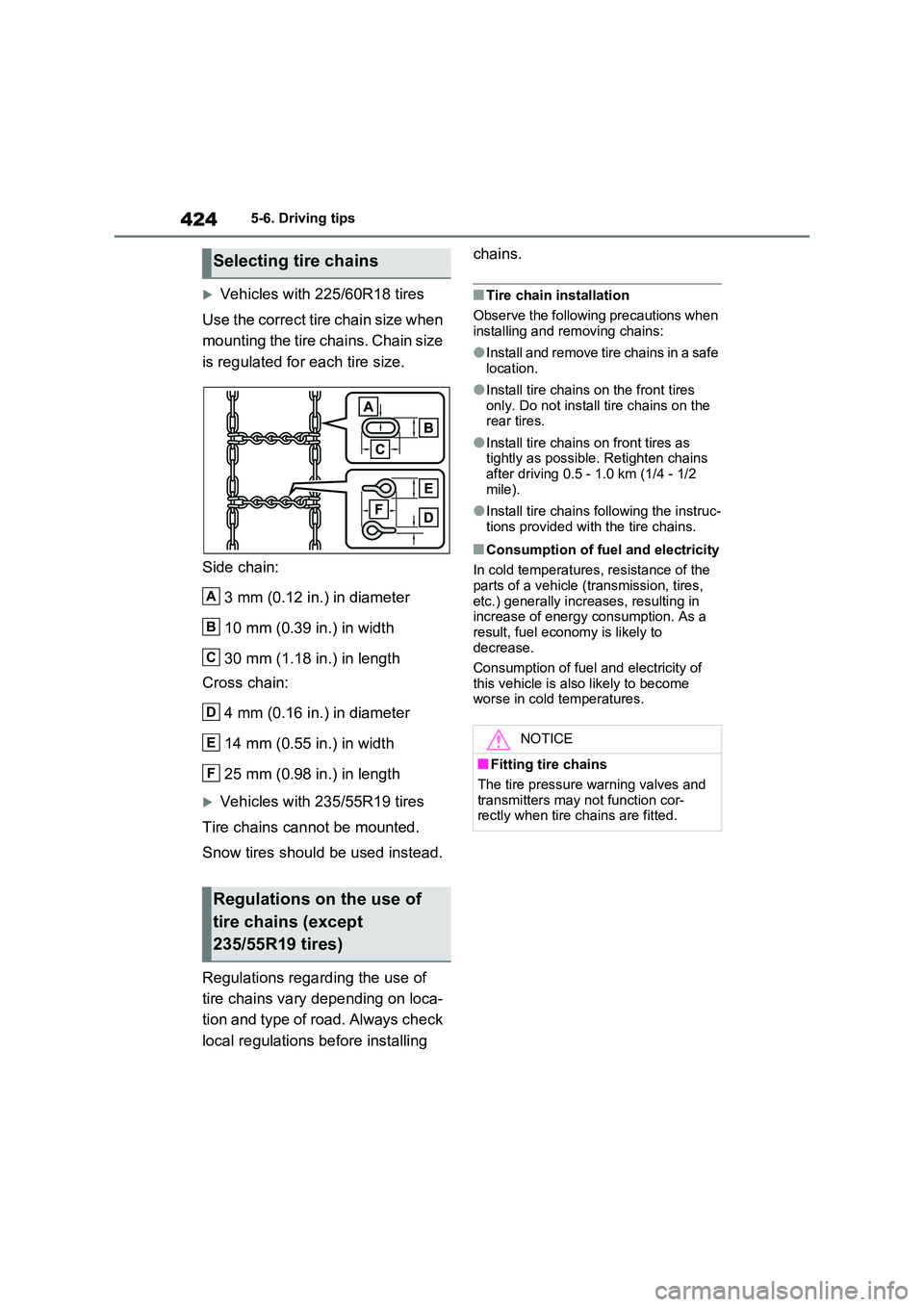
4245-6. Driving tips
Vehicles with 225/60R18 tires
Use the correct tire chain size when
mounting the tire chains. Chain size
is regulated for each tire size.
Side chain:
3 mm (0.12 in.) in diameter
10 mm (0.39 in.) in width
30 mm (1.18 in.) in length
Cross chain:
4 mm (0.16 in.) in diameter
14 mm (0.55 in.) in width
25 mm (0.98 in.) in length
Vehicles with 235/55R19 tires
Tire chains cannot be mounted.
Snow tires should be used instead.
Regulations regarding the use of
tire chains vary depending on loca-
tion and type of road. Always check
local regulations before installing
chains.
■Tire chain installation
Observe the following precautions when installing and removing chains:
●Install and remove tire chains in a safe location.
●Install tire chains on the front tires only. Do not install tire chains on the rear tires.
●Install tire chains on front tires as tightly as possible. Retighten chains
after driving 0.5 - 1.0 km (1/4 - 1/2 mile).
●Install tire chains following the instruc-tions provided with the tire chains.
■Consumption of fuel and electricity
In cold temperatures, resistance of the
parts of a vehicle (transmission, tires, etc.) generally increases, resulting in increase of energy consumption. As a
result, fuel economy is likely to decrease.
Consumption of fuel and electricity of
this vehicle is also likely to become worse in cold temperatures.
Selecting tire chains
Regulations on the use of
tire chains (except
235/55R19 tires)
A
B
C
D
E
F
NOTICE
■Fitting tire chains
The tire pressure warning valves and transmitters may not function cor-rectly when tire chains are fitted.
Page 570 of 718
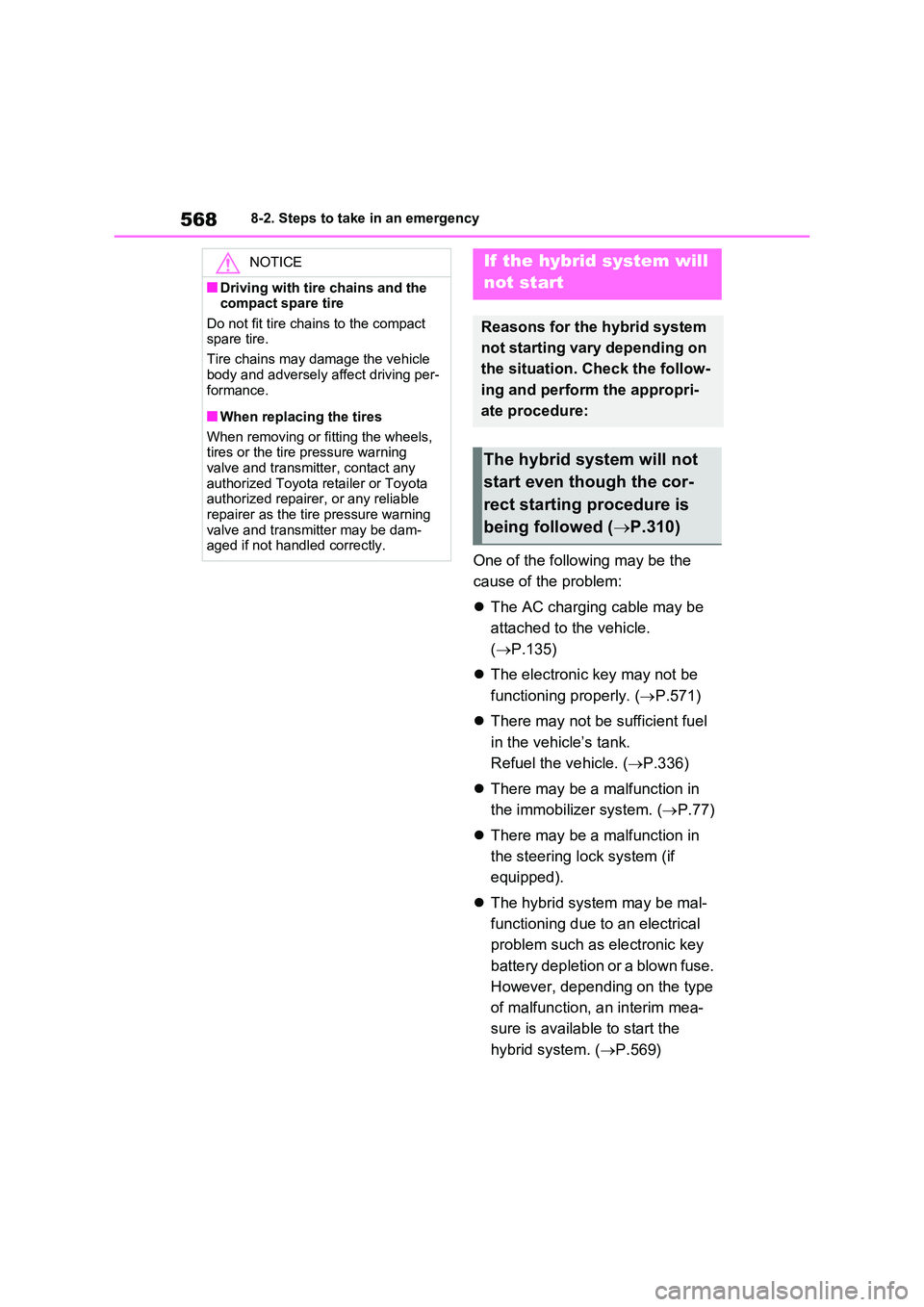
5688-2. Steps to take in an emergency
One of the following may be the
cause of the problem:
The AC charging cable may be
attached to the vehicle.
( P.135)
The electronic key may not be
functioning properly. ( P.571)
There may not be sufficient fuel
in the vehicle’s tank.
Refuel the vehicle. ( P.336)
There may be a malfunction in
the immobilizer system. ( P.77)
There may be a malfunction in
the steering lock system (if
equipped).
The hybrid system may be mal-
functioning due to an electrical
problem such as electronic key
battery depletion or a blown fuse.
However, depending on the type
of malfunction, an interim mea-
sure is available to start the
hybrid system. ( P.569)
NOTICE
■Driving with tire chains and the compact spare tire
Do not fit tire chains to the compact spare tire.
Tire chains may damage the vehicle
body and adversely affect driving per- formance.
■When replacing the tires
When removing or fitting the wheels, tires or the tire pressure warning
valve and transmitter, contact any authorized Toyota retailer or Toyota authorized repairer, or any reliable
repairer as the tire pressure warning valve and transmitter may be dam-aged if not handled correctly.
If the hybrid system will
not start
Reasons for the hybrid system
not starting vary depending on
the situation. Check the follow-
ing and perform the appropri-
ate procedure:
The hybrid system will not
start even though the cor-
rect starting procedure is
being followed ( P.310)
Page 588 of 718
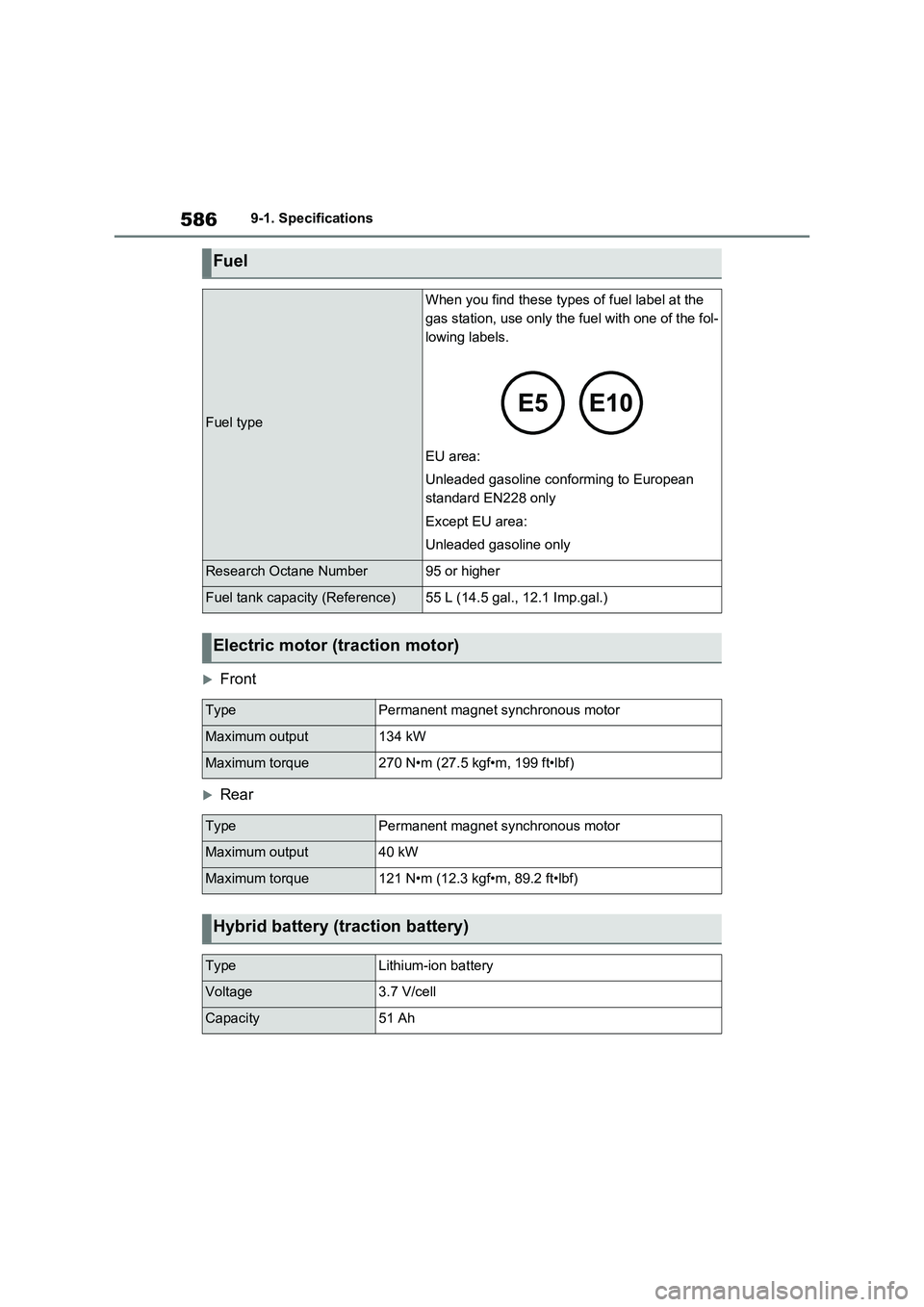
5869-1. Specifications
Front
Rear
Fuel
Fuel type
When you find these types of fuel label at the
gas station, use only the fuel with one of the fol-
lowing labels.
EU area:
Unleaded gasoline conforming to European
standard EN228 only
Except EU area:
Unleaded gasoline only
Research Octane Number95 or higher
Fuel tank capacity (Reference)55 L (14.5 gal., 12.1 Imp.gal.)
Electric motor (traction motor)
TypePermanent magnet synchronous motor
Maximum output134 kW
Maximum torque270 N•m (27.5 kgf•m, 199 ft•lbf)
TypePermanent magnet synchronous motor
Maximum output40 kW
Maximum torque121 N•m (12.3 kgf•m, 89.2 ft•lbf)
Hybrid battery (traction battery)
TypeLithium-ion battery
Voltage3.7 V/cell
Capacity51 Ah
Page 590 of 718
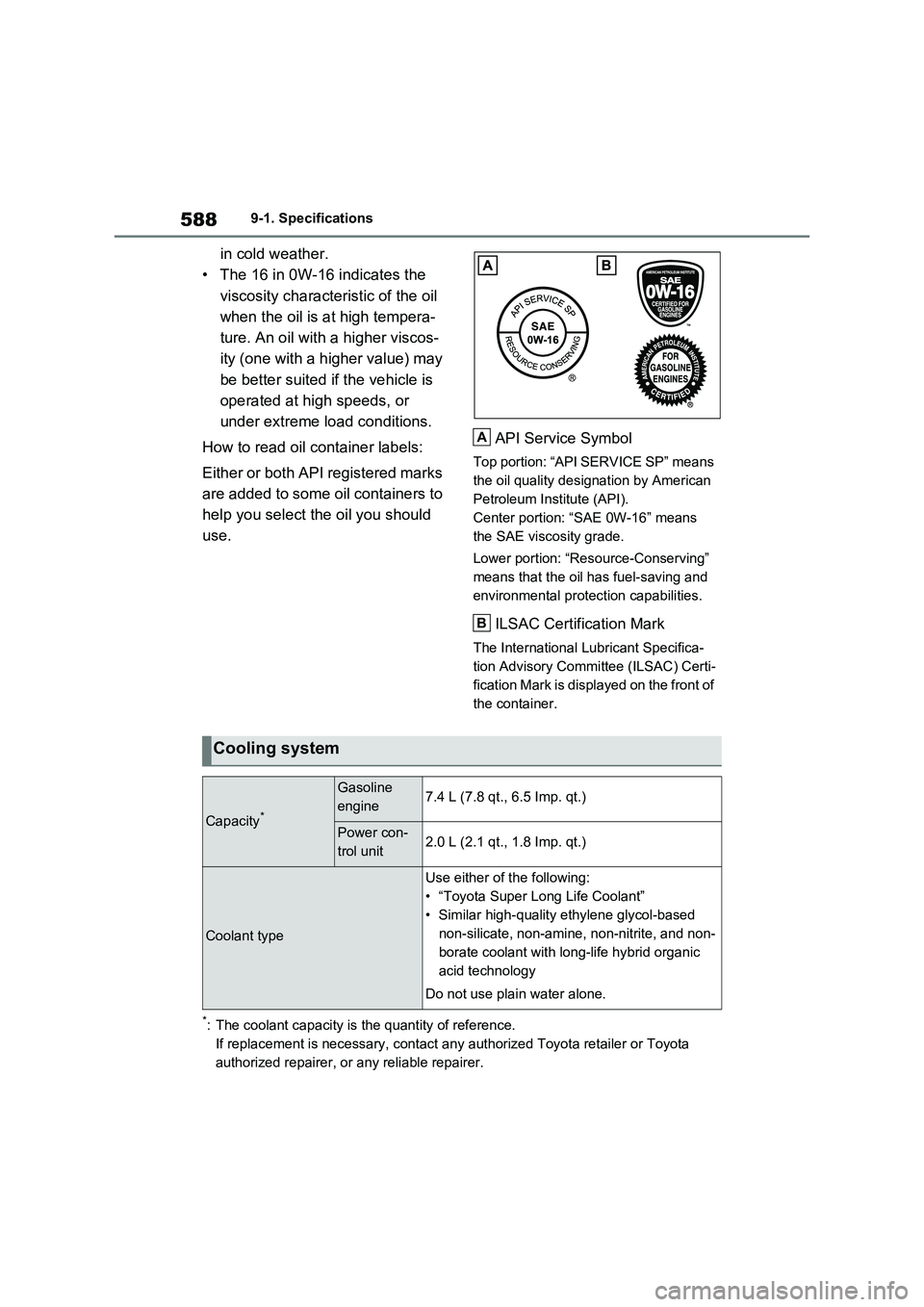
5889-1. Specifications
in cold weather.
• The 16 in 0W-16 indicates the
viscosity characteristic of the oil
when the oil is at high tempera-
ture. An oil with a higher viscos-
ity (one with a higher value) may
be better suited if the vehicle is
operated at high speeds, or
under extreme load conditions.
How to read oil container labels:
Either or both API registered marks
are added to some oil containers to
help you select the oil you should
use.API Service Symbol
Top portion: “API SERVICE SP” means
the oil quality designation by American
Petroleum Institute (API).
Center portion: “SAE 0W-16” means
the SAE viscosity grade.
Lower portion: “Resource-Conserving”
means that the oil has fuel-saving and
environmental protection capabilities.
ILSAC Certification Mark
The International Lubricant Specifica-
tion Advisory Committee (ILSAC) Certi-
fication Mark is displayed on the front of
the container.
*: The coolant capacity is the quantity of reference.
If replacement is necessary, contact any authorized Toyota retailer or Toyota
authorized repairer, or any reliable repairer.
A
B
Cooling system
Capacity*
Gasoline
engine7.4 L (7.8 qt., 6.5 Imp. qt.)
Power con-
trol unit2.0 L (2.1 qt., 1.8 Imp. qt.)
Coolant type
Use either of the following:
• “Toyota Super Long Life Coolant”
• Similar high-quality ethylene glycol-based
non-silicate, non-amine, non-nitrite, and non-
borate coolant with long-life hybrid organic
acid technology
Do not use plain water alone.
Page 594 of 718
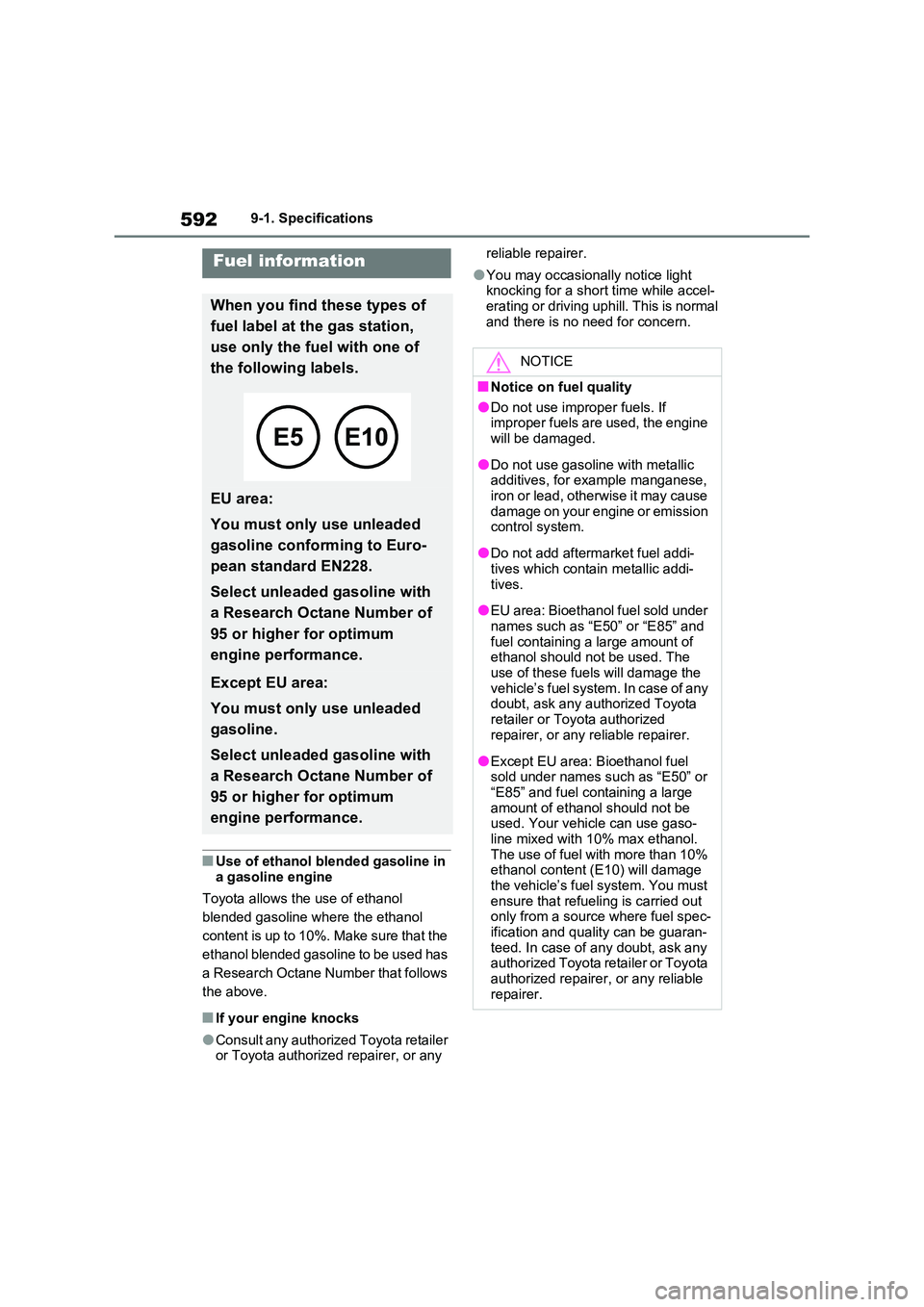
5929-1. Specifications
■Use of ethanol blended gasoline in
a gasoline engine
Toyota allows the use of ethanol
blended gasoline where the ethanol
content is up to 10%. Make sure that the
ethanol blended gasoline to be used has
a Research Octane Number that follows
the above.
■If your engine knocks
●Consult any authorized Toyota retailer or Toyota authorized repairer, or any
reliable repairer.
●You may occasionally notice light knocking for a short time while accel-
erating or driving uphill. This is normal and there is no need for concern.
Fuel information
When you find these types of
fuel label at the gas station,
use only the fuel with one of
the following labels.
EU area:
You must only use unleaded
gasoline conforming to Euro-
pean standard EN228.
Select unleaded gasoline with
a Research Octane Number of
95 or higher for optimum
engine performance.
Except EU area:
You must only use unleaded
gasoline.
Select unleaded gasoline with
a Research Octane Number of
95 or higher for optimum
engine performance.
NOTICE
■Notice on fuel quality
●Do not use improper fuels. If improper fuels are used, the engine will be damaged.
●Do not use gasoline with metallic additives, for example manganese,
iron or lead, otherwise it may cause damage on your engine or emission control system.
●Do not add aftermarket fuel addi-tives which contain metallic addi-
tives.
●EU area: Bioethanol fuel sold under
names such as “E50” or “E85” and fuel containing a large amount of ethanol should not be used. The
use of these fuels will damage the vehicle’s fuel system. In case of any doubt, ask any authorized Toyota
retailer or Toyota authorized repairer, or any reliable repairer.
●Except EU area: Bioethanol fuel sold under names such as “E50” or “E85” and fuel containing a large
amount of ethanol should not be used. Your vehicle can use gaso-line mixed with 10% max ethanol.
The use of fuel with more than 10% ethanol content (E10) will damage the vehicle’s fuel system. You must
ensure that refueling is carried out only from a source where fuel spec-ification and quality can be guaran-
teed. In case of any doubt, ask any authorized Toyota retailer or Toyota authorized repairer, or any reliable
repairer.
Page 599 of 718
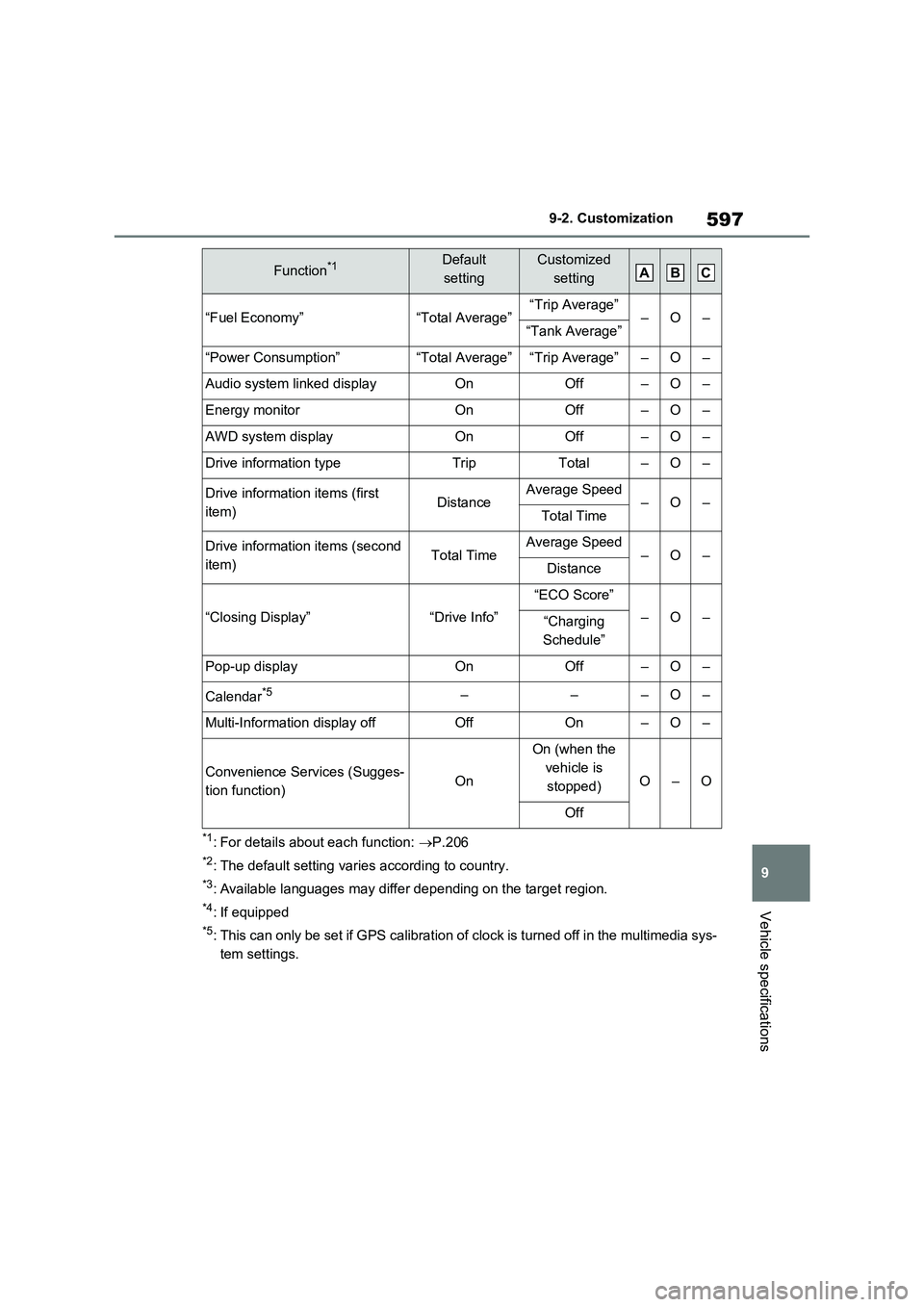
597
9 9-2. Customization
Vehicle specifications
*1: For details about each function: P.206
*2: The default setting varies according to country.
*3: Available languages may differ depending on the target region.
*4: If equipped
*5: This can only be set if GPS calibration of clock is turned off in the multimedia sys-
tem settings.
“Fuel Economy”“Total Average”“Trip Average”–O–“Tank Average”
“Power Consumption”“Total Average”“Trip Average”–O–
Audio system linked displayOnOff–O–
Energy monitorOnOff–O–
AWD system displayOnOff–O–
Drive information typeTripTotal–O–
Drive information items (first
item)DistanceAverage Speed–O–Total Time
Drive information items (second
item)Total TimeAverage Speed–O–Distance
“Closing Display”“Drive Info”
“ECO Score”
–O–“Charging
Schedule”
Pop-up displayOnOff–O–
Calendar*5–––O–
Multi-Information display offOffOn–O–
Convenience Services (Sugges-
tion function)On
On (when the
vehicle is
stopped)
O–O
Off
Function*1Default
settingCustomized
settingABC
Page 600 of 718
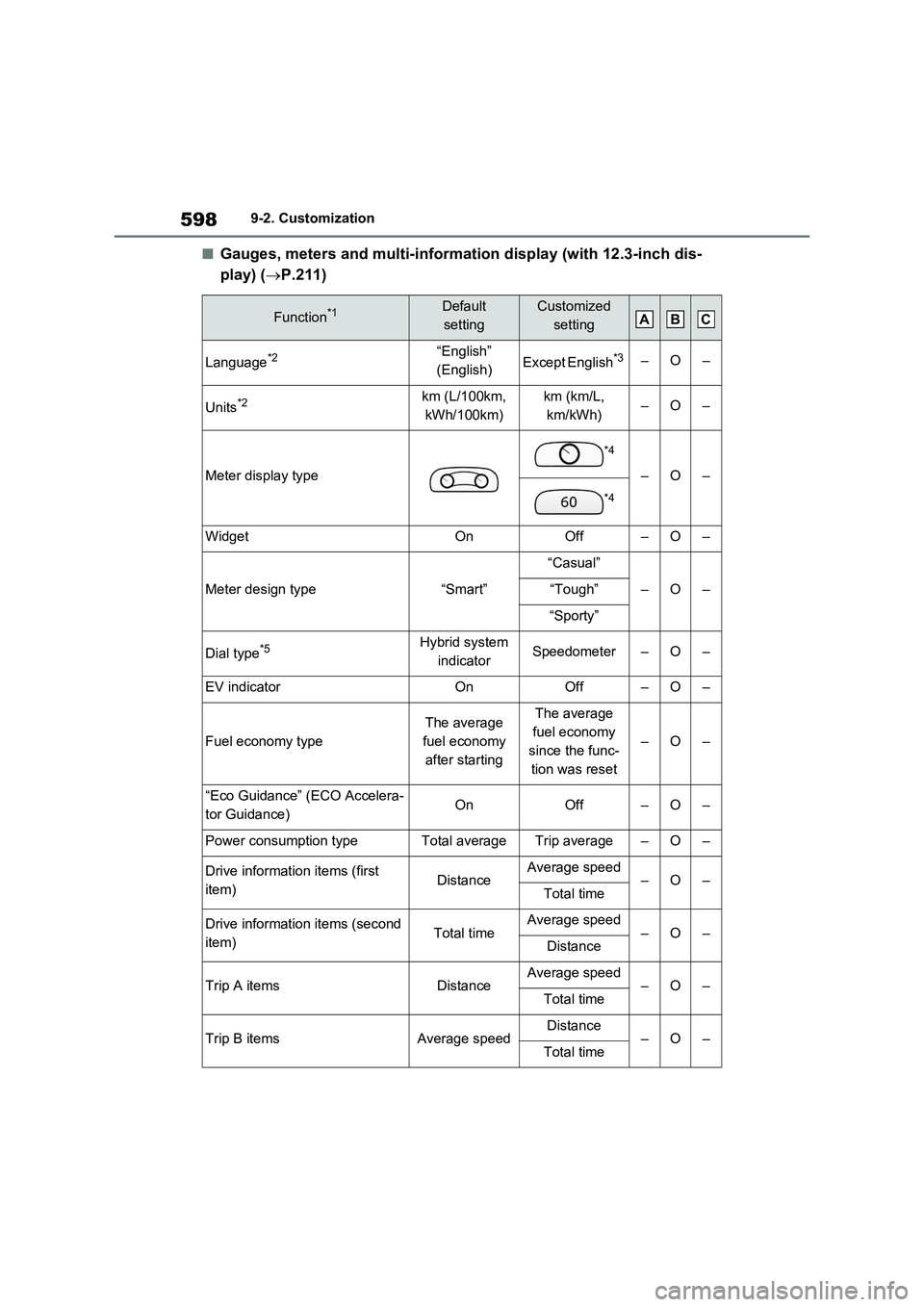
5989-2. Customization
■Gauges, meters and multi-information display (with 12.3-inch dis-
play) (P.211)
Function*1Default
settingCustomized
setting
Language*2“English”
(English)Except English*3 –O–
Units*2km (L/100km,
kWh/100km)km (km/L,
km/kWh)–O–
Meter display type
*4
–O–
*4
WidgetOnOff–O–
Meter design type“Smart”
“Casual”
–O–“Tough”
“Sporty”
Dial type*5Hybrid system
indicatorSpeedometer–O–
EV indicatorOnOff–O–
Fuel economy type
The average
fuel economy
after startingThe average
fuel economy
since the func-
tion was reset
–O–
“Eco Guidance” (ECO Accelera-
tor Guidance)OnOff–O–
Power consumption typeTotal averageTrip average–O–
Drive information items (first
item)DistanceAverage speed–O–Total time
Drive information items (second
item)Total timeAverage speed–O–Distance
Trip A itemsDistanceAverage speed–O–Total time
Trip B itemsAverage speedDistance–O–Total time
ABC